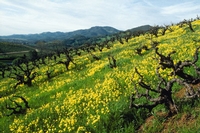Kim Stare Wallace was dismayed to see how many old Zinfandel vines in Sonoma were being ripped out and replaced with Cabernet and other varietals that are more popular with consumers today. Kim, you see, loves Zinfandel, as does Dave Stare, who is her father and  also the founder of the family’s Dry Creek Vineyards in Sonoma County. Since I love good Zin myself, I consider Dave and Kim, and her husband Don Wallace (the winery’s current president), and all the rest of the Dry Creek Vineyards team, heroes for their determination to save the region’s signature Zinfandel vines.
also the founder of the family’s Dry Creek Vineyards in Sonoma County. Since I love good Zin myself, I consider Dave and Kim, and her husband Don Wallace (the winery’s current president), and all the rest of the Dry Creek Vineyards team, heroes for their determination to save the region’s signature Zinfandel vines.
Take the efforts that went into DCV’s Heritage Zinfandel. In 1982, Dry Creek’s vineyard manager Duff Bevill launched a project to save very old Zinfandel vineyards. His strategy involved taking cuttings from Mazzoni Ranch, a pre-Prohibition vineyard located near Geyserville. After carefully screening the cuttings, by the 1990’s he was ready to graft them onto new rootstock to create virus-free vines that would produce wines with “old vine” characteristics. The result is Dry Creek Heritage Zinfandel, a ripe, juicy, powerful wine made from a blend of 87% Zinfandel amplified by 18% Petite Sirah. (Its $19 price tag is another reason to seek out this fine wine.)
Dry Creek Vineyards was one of the first California wineries to use the term “old vines,” on its Old Vine Zinfandel. The grapes that have gone into the current 2008 vintage were harvested from vines that have an average age of 85 years, with some of them as old as 120 years. The botanical equivalent of elder statesmen, these vines tend to produce very small berries replete  with concentrated, ultra-flavorful juice. With its color and structure boosted by the addition of some Petite Sirah, Old Vine Zinfandel has rich, deep flavors of blackberries, blueberries, pepper and other exotic spice. ($28)
with concentrated, ultra-flavorful juice. With its color and structure boosted by the addition of some Petite Sirah, Old Vine Zinfandel has rich, deep flavors of blackberries, blueberries, pepper and other exotic spice. ($28)
The fruit that goes into Somers Ranch Zinfandel actually comes from two separate old vineyards planed on adjacent hilltops. In the 1990s Don Wallace grafted new rootstock on the vines in both blocks. Although the vines are still comparatively young for a heritage vineyard, the wines already show layers of densely packed aromas and flavors. Tasting the 2008 vintage recently, I got vivid suggestions of blueberries and cassis, plus a little smokiness reminiscent of Lapsang Souchong tea. The wine also has a velvety texture and substantial, lingering finish. Because the vineyards are small (two 3-acre parcels), a mere 462 cases of 2008 Somers Ranch Zin was produced. ($34)
Each of the Dry Creek Vineyard Zinfandels has its own personality and subtle expression of individual terroir. What they have in common is extreme vitality supported by a graceful structure. And here’s something else they share: As soon as one of these heritage wines hits the palate it will produce that mysterious rush of emotion familiar to all true Zin lovers. For this, my thanks go out to Kim Stare Wallace for loving Zinfandel enough to fight for the survival and refinement of this this great, good grape.
7
